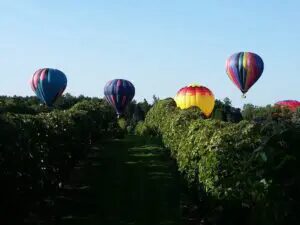Discover Minnesota
Wine Country
Our Minnesota Wine Travel Guide shares a brief history of the state's wine country, terroir, where to sip, where to stay and things to do beyond the vines.
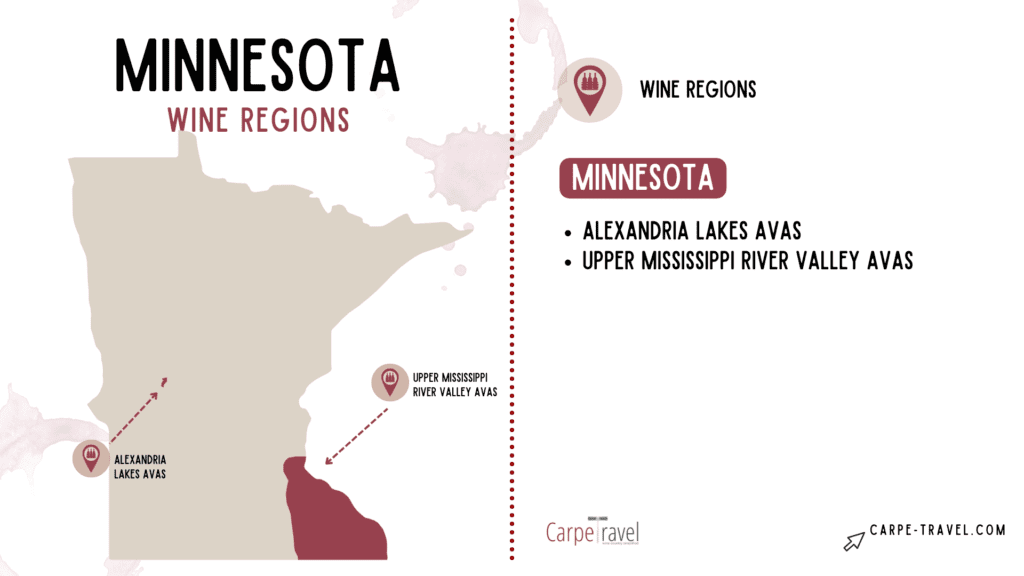
WHERE IS MINNESOTA WINE COUNTRY?
Most of Minnesota’s wineries are in the southeastern portion of the state, along the St. Croix, Mississippi, and Cannon River Valleys. Popular destinations including Minneapolis, Stillwater, and Red Wing are great jumping off points to sip in Minnesota wine country.
BEST TIMES TO VISIT
Plan to skip winter in Minnesota wine country and aim visiting the wineries during the spring, summer or fall.
TOP GRAPE VARIETIES IN MINNESOTA
Top grape varieties in Minnesota include Frontenac, Frontenac Gris, Itasca, La Crescent, and Marquette, all cold-hardy grapes developed by the University of Minnesota to be ideally suited to the state’s climate. Traditionally, wines produced from cold-hardy grapes tend to be lighter-bodied and lower in alcohol, with a higher level of sweetness and acidity. However, newer grape varietals are being used to produce more complex wines. Marquette yields medium-bodied, drier, and more tannic red wines with moderate acidity, featuring aromas of cherry, blackberries, plum, and spice. These red wines are balanced, offering harmonious flavors with hints of tobacco that add depth and complexity.
La Crescent can be used to produce crisp white wines reminiscent of Reisling, with vibrant tropical fruit flavors and aromas that enhance their appeal.
Minnesota's wine industry may be small (the state's wineries produce less than one percent of U.S. wine) but it has a rich history.
Minnesota has long been home to native wild grapes—the Dakota and Ojibwa, Minnesota’s indigenous inhabitants, ate and used them in pemmican, a traditional food made with dried meat, fat, and fruit.
After the Civil War, European-Americans began developing hybrids that combined Minnesota’s native wild grapes with domestic varieties from other parts of the world. Scientists at the University of Minnesota bred grapes throughout the late 19th and early 20th centuries, releasing four named grape varieties in 1944.
During this time period, Minnesota’s wine industry was extremely limited. Italian immigrants to northern Minnesota’s Iron Range shipped in truckloads of grapes from California and produced wine at unlicensed, communal wineries. Minnesota’s first winery license was issued shortly after Prohibition to the Old Sibley House Winery, which operated in West St. Paul until 1949 and relied on grapes from other states.
Minnesota’s modern wine industry dates to the 1970s. David A. Bailly planted Minnesota’s first vineyard in 1973. His winery, Alexis Bailly Vineyard, opened its tasting room in 1978, serving the first commercially-produced wines made solely with Minnesota-grown grapes. Many wine enthusiasts are not familiar with Minnesota wines and are often surprised by how good they are. Local winemakers take great pride in their achievements and the production of good wines from cold-hardy grape varieties.
The state’s nascent wine industry soon got a boost from the University of Minnesota, which began developing high-quality, cold-hardy, and disease-resistant wine grape cultivars. Elmer Swenson, a self-taught grape breeder often considered the father of modern cold climate viticulture, played an important role in the University’s early efforts. Swenson worked at the University as a technician from 1969-1979, collaborating on the joint release of the Edelweiss grape in 1977.
Today, the University of Minnesota has one of the top wine grape research programs in the country, with an enology lab, winery, and 12,000 experimental vines across 12 acres. The cold-hardy varieties the University has developed—including Frontenac, Marquette, and La Crescent—are grown in cold-climate wine regions around the world, as well as at Minnesota’s 70+ wineries.
TERROIR
The obvious characteristic of Minnesota’s terrior is the cold climate—grapes need to survive winter temperatures that can drop to 30 degrees below zero Fahrenheit. As a result, Minnesota’s wine industry relies on cold-hardy grapes developed by the University of Minnesota, which combine the sturdiness of native wild grapes with the flavor of European varietals.
Minnesota is home to two designated American Viticultural Areas (AVAs) and 70+ wineries. The Alexandria Lakes AVA covers 10,880 acres in central Minnesota and is one of the smaller AVAs in the state. It is home to some of the deepest lakes in MN, with six freshwater lakes making up its boundaries. This helps moderate the local climate, although the AVA primarily relies on cold-hardy grapes. It is home to one winery, Carlos Creek Winery.
Southeastern Minnesota is part of the Upper Mississippi River Valley AVA. At nearly 30,000 square miles, it is the largest AVA and includes portions of Minnesota, Wisconsin, Iowa, and Illinois. Also known as the Driftless Area, it remained uncovered by glaciers during the last ice age and is geologically distinct from the surrounding landscape. Many of Minnesota’s top wineries are located within the Upper Mississippi River AVA, including Alexis Bailly Vineyard, the first winery to make commercially-produced wines solely from Minnesota grapes. In addition to the large Upper Mississippi River Valley AVA, Minnesota is home to smaller AVAs like Alexandria Lakes, which contribute to the state’s diverse wine landscape.
The short growing season in MN, with its cold winters and brief summers, affects grape ripening and wine production, making cold-hardy grape varieties essential for success. Despite these challenges, wineries in these AVAs have produced award winning wines and received awards at major wine competitions, including honors from the International Cold Climate Wine Competition, highlighting the quality and recognition of Minnesota’s wine industry.
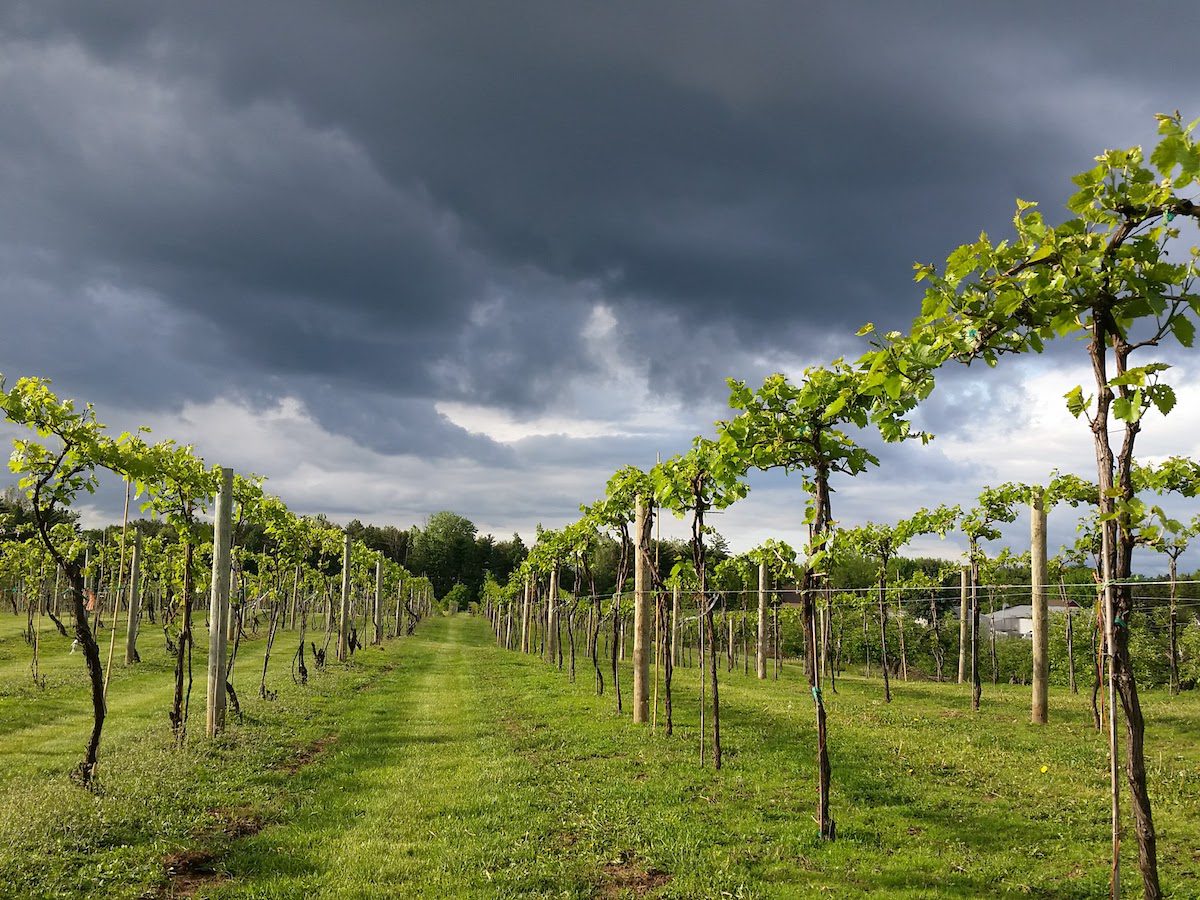
Planning Your MINNESOTA Wine Country Vacation
MINNESOTA WINE TASTING ITINERARIES
WHERE TO STAY IN MINNESOTA WINE COUNTRY
GETTING AROUND
Private drivers may seem like a dime a dozen, but not all those dimes are equal. Look for those who are well rated and/or ask your hotel for recommendations.
WHERE TO SIP
With over 70 wine producers spread across the state, deciding which Minnesota wineries to visit can be a challenge. Luckily, we’ve narrowed it down for you with this roundup of our favorite Minnesota wineries. Many Minnesota wineries also offer shipping options, so you can enjoy local wines at home.
These Minnesota wineries are conveniently located to popular destinations including Minneapolis, Stillwater, and Red Wing, and offer scenic views, delicious eats, and fun events in addition to high-quality wines made from Minnesota-grown grapes.
Alexis Bailly Vineyard
Alexis Bailly Vineyard, located approximately 30 miles southeast of Minneapolis, is a pioneer among Minnesota wineries. In 1973, founder David Bailly planted the state’s first vineyard, and in 1978, the winery’s tasting room started serving the first commercially-produced wines made solely from Minnesota-grown grapes. Today, the second-generation winery is helmed by owner and winemaker Nan Bailly. Wines combine French and estate-grown Minnesota varietals, and all wines are vegan. In addition to a traditional tasting room, visitors can reserve a wine yurt for a unique tasting experience.
18200 Kirby Avenue South, Hastings; 651-437-1413
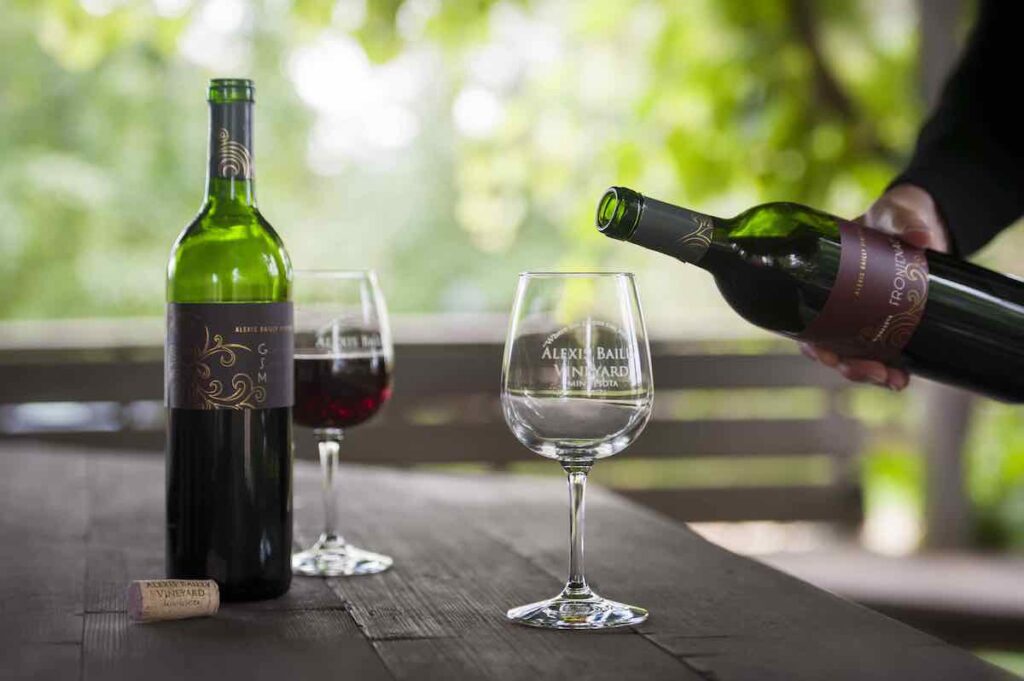
Cannon River Winery
Cannon River Winery, located in southeastern Minnesota, has a picturesque 20-acre vineyard in the Sogn Valley. In the fall, visitors can participate in a hands-on Grape Harvest Experience that includes a tasting of fresh grapes and the finished wine. The tasting room, located nearby in downtown Cannon Falls, offers wine flights, wine by the glass, and staff-guided Tableside Tastings year round.
421 Mill Street West, Cannon Falls; 507-263-7400
Parley Lake Winery
Located just west of Minneapolis near Lake Waconia, Parley Lake Winery is open seasonally, with a family and dog-friendly atmosphere, live music, and food trucks. In addition to cold-hardy grapes, some wines feature apples grown at the on-site orchard. The tasting room offers wine flights, guided wine tastings, locally-made gourmet snacks, and local craft sodas.
8280 Parley Lake Road, Waconia
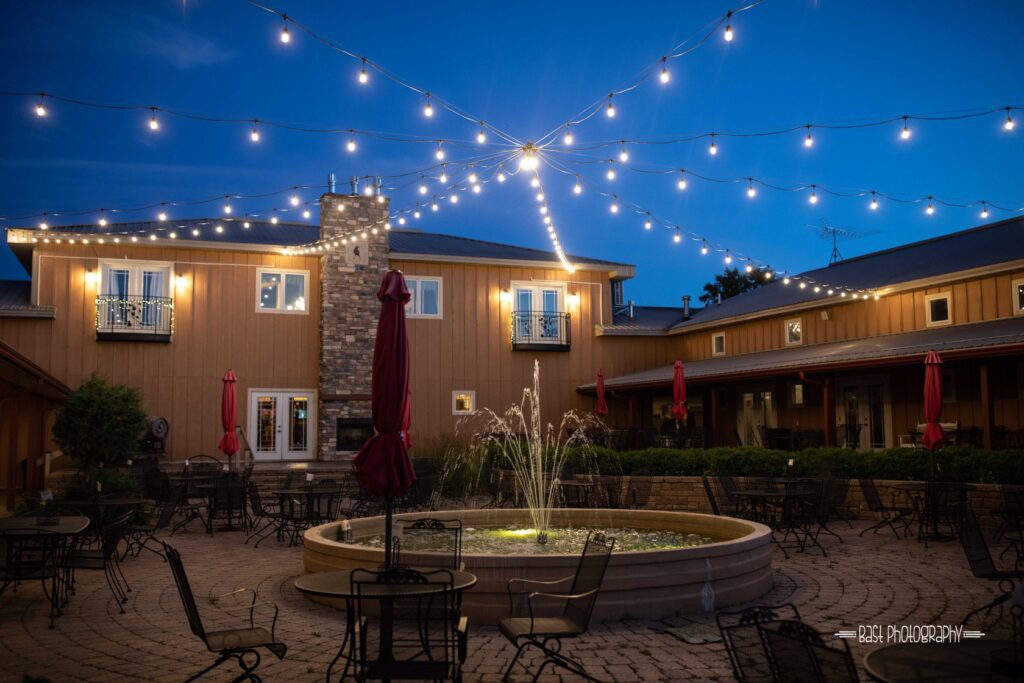
Crow River Winery
Crow River Winery is situated about 60 miles west of Minneapolis, at the edge of Minnesota’s prairie region. Grapes are sourced from the winery’s five vineyards, where proprietors Valerie and MIke McBrady also grow garlic and keep bees. (Garlic makes an appearance in the smoked garlic cooking wine, while Apiary is a sweet red wine that combines honey with Frontenac grapes). Pair a build-your-own tasting flight with artisan pizza at the tasting room and bistro.
14848 Highway 7 East, Hutchinson; 320-587-2922
Schram Vineyards
Home to Minnesota’s first combined winery and brewery, Schram Vineyards is a short drive west of Minneapolis. The rustic-chic tasting room serves both wine and beer flights, plus wine-friendly shareable bites. For an in-depth experience, book a tasting in the Barrel Room, which offers a more intimate atmosphere. The winery often hosts special events ranging from wine and cheese pairing classes to yoga in the vineyard.
8785 Airport Road, Waconia; 952-442-5105
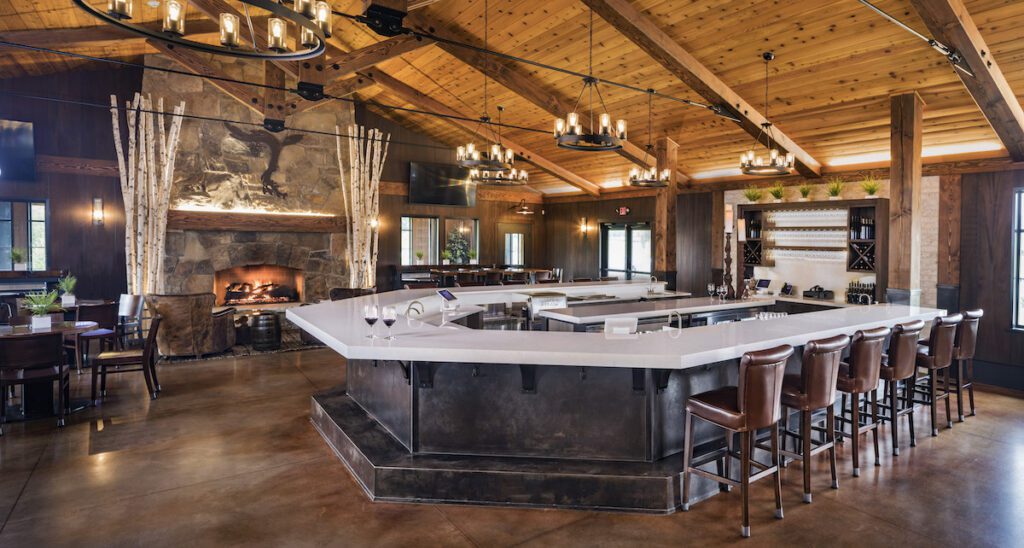
7 Vines Vineyard
Just 20 miles northeast of Minneapolis, 7 Vines Vineyard has an upscale, modern atmosphere, with handcrafted woodwork, stone fireplaces, and a steel catwalk offering a view of the production process. Behind-the-scenes tours (which include a tasting) are available, or visitors can opt for samples, flights, or wine by the glass at the elegant wine bar, which also serves contemporary American cuisine.
101 Highway 96 East, Dellwood; 651-478-6300
Wild Mountain Winery
Situated about 60 miles northeast of Minneapolis near the Wisconsin border, Wild Mountain Winery boasts a scenic location on one of the highest points in Chisago County. The partially wooded setting makes sipping outside especially appealing, with several patios adjacent to the tasting room. Visitors can even stay on-site at the Wild Vines Campground, which has campsites nestled throughout the woods and vineyards.
16906 Wild Mountain Road, Taylors Falls; 651-583-3585
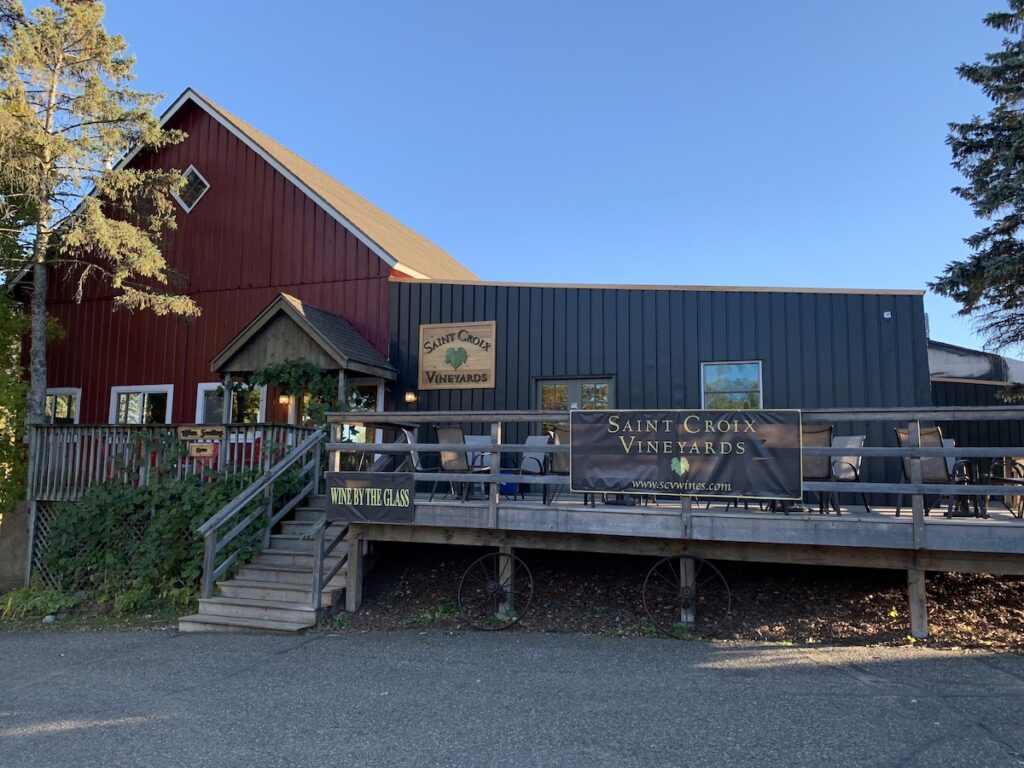
Saint Croix Vineyards
Located near Stillwater, Saint Croix Vineyards has a relaxed, rural feel, with a tasting room housed in a restored century-old barn. Visitors are welcome to bring a picnic meal to enjoy in the vineyard. Free public tours are offered on Saturdays during the summer, and private tours (which include a glass of wine, and a wine flight accompanied by cheese, crackers, and dessert) are available year round. In addition to red and white wines, the winery produces port and a popular raspberry-infused dessert wine.
6428 Manning Avenue, Stillwater; 651-430-3310
Carlos Creek Winery
Carlos Creek Winery, a short drive from Alexandria in west-central Minnesota, has a nice selection of sparkling wines, including Minnescato, a semi-sweet white wine made with a blend of Minnesota-grown grapes. Visitors can pair a tasting flight with wood-fired pizzas and enjoy live music on Fridays and Saturdays. The winery is known for its an annual rape stomping festival (held the second weekend after Labor Day) complete with live music, over 150 vendors, wine tasting, and grape stomping competitions.
6693 County Road 34 NW, Alexandria; 320-846-5443
Falconer Vineyards
Located near Red Wing in southeastern Minnesota, Falconer Vineyards produces wine from cold-hardy grapes and cider from Minnesota-grown apples. Wine tastings are available year round, and in the summer months visitors can savor a wood-fired pizza on the vineyard’s deck, which has panoramic views of the surrounding valley. One of the winery’s most awarded offerings is the Frontenac Rosé.
3572 Old Tyler Road, Red Wing; 651-388-8849

BEYOND THE VINES
When it’s time to take a break from wine tasting, Minnesota has plenty to keep the fun going. It’s hard to narrow down all the things to do in Minnesota into a top 10 list, after all the state is the “land of 10,000 lakes”. Not to mention hiking trails, museums and so much more. But, there are a few things you shouldn’t miss when visiting the wine regions.

